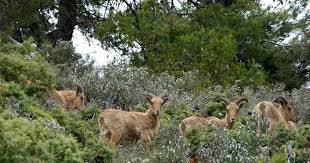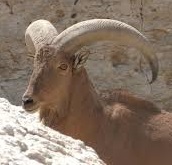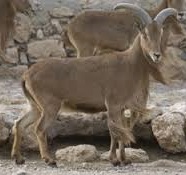The Barbary sheep is a species of caprid (goat-antelope) native to rocky mountains in North Africa. Six
subspecies have been described. Although it is rare in its native North Africa, it has been introduced to
North America, southern Europe, and elsewhere. It is also known as aoudad, waddan, arui, and arruis.
Description
Barbary sheep stand 80 to 100 cm (2.6 to 3.3 ft) tall at the shoulder and weigh 40 to 140 kg (88 to 309 lb).
They are a sandy-brown color, darkening with age, with a slightly lighter underbelly and a darker line along
the back. Upper parts and the outer parts of the legs are a uniform reddish brown or grayish brown. There is
some shaggy hair on the throat (extending down to the chest in males) and a sparse mane. Their horns have a
triangular cross section. The horns curve outwards, backwards, then inwards, and reach up to 50 cm (20 in).
The horns are fairly smooth, with slight wrinkles evident at the base as the animal matures.
Range
Barbary sheep are naturally occurring in northern Africa in Algeria, Tunisia, northern Chad, Egypt, Libya,
northern Mali, Mauritania, Morocco, Niger and Sudan (west of the Nile, and in the Red Sea Hills east of the
Nile).
Habitat

Barbary sheep are found in arid mountainous areas where they graze and browse grasses, bushes, and lichens.
They are able to obtain all their moisture from food, but if liquid water is available, they drink it and
wallow in it. Barbary sheep are crepuscular: active in the early morning and late afternoon and resting in
the heat of the day. They are very agile and can achieve a standing jump of over 2 metres (7 ft). Barbary
sheep flee at the first sign of danger. They are well adapted to their habitats, which consist of steep
rocky mountains and canyons. When threatened, they always run up and bounce back and forth over the tops of
the mountains to elude predators below. They stay in rough, steep country because they are more suited to
the terrain than any of their predators. Aoudad are extremely nomadic and travel constantly via mountain
ranges. Their main predators in North Africa were the Barbary leopard, the Barbary lion, and caracal, but
nowadays only humans threaten their populations.







